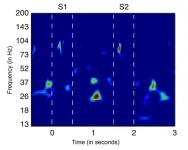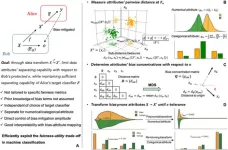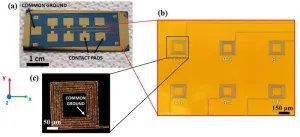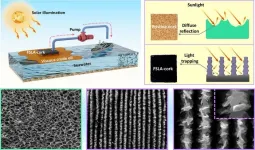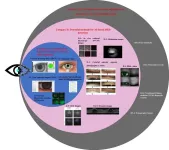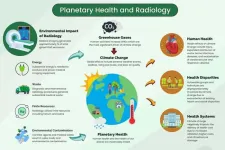(Press-News.org) The brain processes information on many scales. Individual cells electrochemically transmit signals in circuits but at the large scale required to produce cognition, millions of cells act in concert, driven by rhythmic signals at varying frequencies. Studying one frequency range in particular, beta rhythms between about 14-30 Hz, holds the key to understanding how the brain controls cognitive processes—or loses control in some disorders—a team of neuroscientists argues in a new review article.
Drawing on experimental data, mathematical modeling and theory, the scientists make the case that bursts of beta rhythms control cognition in the brain by regulating where and when higher gamma frequency waves can coordinate neurons to incorporate new information from the senses or formulate plans of action. Beta bursts, they argue, quickly establish flexible but controlled patterns of neural activity for implementing intentional thought.
“Cognition depends on organizing goal-directed thought, so if you want to understand cognition, you have to understand that organization,” said co-author Earl K. Miller, Picower Professor in The Picower Institute for Learning and Memory and the Department of Brain and Cognitive Sciences at MIT. “Beta is the range of frequencies that can control neurons at the right spatial scale to produce organized thought.”
Miller and colleagues Mikael Lundqvist, Jonatan Nordmark and Johan Liljefors at the Karolinska Institutet and Pawel Herman at the KTH Royal Institute of Technology in Sweden, write that studying bursts of beta rhythms to understand how they emerge and what they represent would not only help explain cognition, but also aid in diagnosing and treating cognitive disorders.
“Given the relevance of beta oscillations in cognition, we foresee a major change in the practice for biomarker identification, especially given the prominence of beta bursting in inhibitory control processes … and their importance in ADHD, schizophrenia and Alzheimer’s disease,” they write in the journal Trends in Cognitive Sciences.
Beta data
Experimental studies covering several species including humans, a variety of brain regions, and numerous cognitive tasks have revealed key characteristics of beta waves in the cortex, the authors write: Beta rhythms occur in quick but powerful bursts; they inhibit the power of higher frequency gamma rhythms; and though they originate in deeper brain regions, they travel within specific locations of cortex. Considering these properties together, the authors write that they are all consistent with precise and flexible regulation, in space and time, of the gamma rhythm activity that experiments show carry signals of sensory information and motor plans.
“Beta bursts thus offer new opportunities for studying how sensory inputs are selectively processed, reshaped by inhibitory cognitive operations and ultimately result in motor actions,” the authors write.
For one example, Miller and colleagues have shown in animals that in the prefrontal cortex in working memory tasks, beta bursts direct when gamma activity can store new sensory information, read out the information when it needs to be used, and then discard it when it’s no longer relevant. For another example, other researchers have shown that beta rises when human volunteers are asked to suppress a previously learned association between word pairs, or to forget a cue because it will no longer be used in a task.
In a paper last year, Lundqvist, Herman, Miller and others cited several lines of experimental evidence to hypothesize that beta bursts implement cognitive control spatially in the brain, essentially constraining patches of the cortex to represent the general rules of a task even as individual neurons within those patches represent the specific contents of information. For example, if the working memory task is to remember a pad lock combination, beta rhythms will implement patches of cortex for the general steps “turn left,” “turn right,” “turn left again,” allowing gamma to enable neurons within each patch to store and later recall the specific numbers of the combination. The two-fold value of such an organizing principle, they noted, is that the brain can rapidly apply task rules to many neurons at a time and do so without having to re-establish the overall structure of the task if the individual numbers change (i.e. you set a new combination).
Another important phenomenon of beta bursts, the authors write, is that they propagate across long distances in the brain, spanning multiple regions. Studying the direction of their spatial travels, as well as their timing, could shed further light on how cognitive control is implemented.
New ideas beget new questions
Beta rhythm bursts can differ not only in their frequency, but also their duration, amplitude, origin and other characteristics. This variety speaks to their versatility, the authors write, but also obliges neuroscientists to study and understand these many different forms of the phenomenon and what they represent to harness more information from these neural signals.
“It quickly becomes very complicated, but I think the most important aspect of beta bursts is the very simple and basic premise that they shed light on the transient nature of oscillations and neural processes associated with cognition,” Lundqvist said.“This changes our models of cognition and will impact everything we do. For a long time we implicitly or explicitly assumed oscillations are ongoing which has colored experiments and analyses. Now we see a first wave of studies based on this new thinking, with new hypothesis and ways to analyze data, and it should only pick up in years to come.”
The authors acknowledge another major issue that must be resolved by further research—How do beta bursts emerge in the first place to perform their apparent role in cognitive control?
“It is unknown how beta bursts arise as a mediator of an executive command that cascades to other regions of the brain,” the authors write.
The authors don’t claim to have all the answers. Instead, they write, because beta rhythms appear to have an integral role in controlling cognition, the as yet unanswered questions are worth asking.
“We propose that beta bursts provide both experimental and computational studies with a window through which to explore the real-time organization and execution of cognitive functions,” they conclude. “To fully leverage this potential there is a need to address the outstanding questions with new experimental paradigms, analytical methods and modeling approaches.”
END
In the brain, bursts of beta rhythms implement cognitive control
Bursts of brain rhythms with “beta” frequencies control where and when neurons in the cortex process sensory information and plan responses. Studying these bursts would improve understanding of cognition and clinical disorders, researchers write
2024-04-23
ELSE PRESS RELEASES FROM THIS DATE:
New mitigation framework reduces bias in classification outcomes
2024-04-23
We use computers to help us make (hopefully) unbiased decisions. The problem is that machine-learning algorithms do not always make fair classifications, if human bias is embedded in the data used to train them — which is often the case in practice. To ease this "garbage in, garbage out" situation, a research team presented a flexible framework for mitigating bias in machine classification. Their research was published Apr. 8 in Intelligent Computing, a Science Partner Journal.
Existing attempts to mitigate classification bias, according to the team, are often held back by their reliance on specific metrics of fairness and predetermined ...
Zap Energy achieves 37-million-degree temperatures in a compact device
2024-04-23
In the nine decades since humans first produced fusion reactions, only a few fusion technologies have demonstrated the ability to make a thermal fusion plasma with electron temperatures hotter than 10 million degrees Celsius, roughly the temperature of the core of the sun. Zap Energy’s unique approach, known as a sheared-flow-stabilized Z pinch, has now joined those rarefied ranks, far exceeding this plasma temperature milestone in a device that is a fraction of the scale of other fusion systems.
A new research paper, published this month in Physical ...
Magnetic microcoils unlock targeted single-neuron therapies for neurodegenerative disorders
2024-04-23
WASHINGTON, April 23, 2024 — Neural stimulation is a medical technique used to treat many illnesses affecting the nervous system. It involves applying energy to neurons to encourage them to grow and make connections with their neighbors. Treatments for epilepsy can often include neural stimulation, and similar treatments exist for Parkinson’s disease, chronic pain, and some psychiatric illnesses.
In the Journal of Vacuum Science & Technology A, by AIP Publishing, researchers from the University of Minnesota deployed an array of microscopic coils — microcoils — to create ...
Laser-treated cork absorbs oil for carbon-neutral ocean cleanup
2024-04-23
WASHINGTON, April 23, 2024 – Oil spills are deadly disasters for ocean ecosystems. They can have lasting impacts on fish and marine mammals for decades and wreak havoc on coastal forests, coral reefs, and the surrounding land. Chemical dispersants are often used to break down oil, but they often increase toxicity in the process.
In Applied Physics Letters, by AIP Publishing, researchers from Central South University, Huazhong University of Science and Technology, and Ben-Gurion University of the Negev used laser treatments to transform ordinary ...
COVID-19 vaccination and incidence of pediatric SARS-CoV-2 infection and hospitalization
2024-04-23
About The Study: The findings of this study including 3.9 million children suggest that vaccination against SARS-CoV-2 was associated with significant reductions in COVID-19 incidence and hospitalizations among children in California.
Authors: Justin V. Remais, Ph.D., of the University of California, Berkeley, is the corresponding author.
To access the embargoed study: Visit our For The Media website at this link https://media.jamanetwork.com/
(doi:10.1001/jamanetworkopen.2024.7822)
Editor’s Note: Please see the article for additional information, including other authors, author contributions and affiliations, conflict of interest and ...
Long-term taste and smell outcomes after COVID-19
2024-04-23
About The Study: Taste dysfunction as measured objectively was absent one year after exposure to COVID-19 while some smell loss remained in nearly one-third of individuals with this exposure, likely explaining taste complaints of many individuals with post–COVID-19 condition in this study of 340 individuals with and 434 individuals without prior COVID-19. Infection with earlier untyped and Alpha variants was associated with the greatest degree of smell loss.
Authors: Shima T. Moein, M.D., Ph.D., of the University of Pennsylvania ...
Artificial intelligence to be used for the detection of common eye disease
2024-04-23
Dry Eye Disease (DED) is one of the more common eye diseases, affecting up to 30% of the world’s population. This disease can affect many different types of people and can wind up being a great hindrance to their overall quality of life. Early screening and prognosis is vital to the patient’s progression with the disease. However, this can be difficult. In this study, researchers aim to use artificial intelligence (AI) to aid in early screening and prognosis of DED. Not only can the use of AI make screening more accessible for ...
A roadmap for digital neuroscience
2024-04-23
Neuroscience has entered a new, digital phase. The combination of brain research with supercomputing in large-scale, multi-disciplinary research collaborations has enabled an innovative approach to deciphering the brain, using powerful scientific technologies and data ressources. These developments open up new possibilities for brain research, medicine and technology. A position paper by over 100 authors, now published in the journal Imaging Neuroscience, summarises the current status and identifies ...
Radiologists propose actions to combat climate change
2024-04-23
OAK BROOK, Ill. – A diverse writing group—lead by authors at the University of Toronto—have developed an approach for radiology departments and practices to reduce their greenhouse gas emissions and become more resilient to the effects of climate change. They outlined their action plan in a Radiology in Focus article, published today in Radiology, a journal of the Radiological Society of North America (RSNA).
“Rising greenhouse gas emission levels lead to climate change, extreme weather events and worsening air pollution with downstream adverse health effects,” said lead author Kate Hanneman, M.D., M.P.H., vice chair of research ...
SwRI to discuss connected vehicle data exchanges, AI tools at 2024 ITS America Conference & Expo
2024-04-23
SAN ANTONIO — April 23, 2024 — During this week’s ITS America Conference & Expo, Southwest Research Institute will share its latest intelligent transportation systems (ITS) research designed to integrate connected vehicle data exchanges and artificial intelligence into public transportation infrastructure.
“SwRI’s ITS solutions are designed to improve safety for the traveling public using software that helps transportation agencies operate more efficiently,” said Josh Johnson, ...
LAST 30 PRESS RELEASES:
Scientists trace microplastics in fertilizer from fields to the beach
The Lancet Obstetrics, Gynecology, & Women’s Health: Taking paracetamol during pregnancy does not increase risk of autism, ADHD or intellectual disabilities, confirms new gold-standard evidence review
Taking paracetamol during pregnancy does not increase risk of autism, ADHD or intellectual disabilities
Harm reduction vending machines in New York State expand access to overdose treatment and drug test strips, UB studies confirm
University of Phoenix releases white paper on Credit for Prior Learning as a catalyst for internal mobility and retention
Canada losing track of salmon health as climate and industrial threats mount
Molecular sieve-confined Pt-FeOx catalysts achieve highly efficient reversible hydrogen cycle of methylcyclohexane-toluene
Investment in farm productivity tools key to reducing greenhouse gas
New review highlights electrochemical pathways to recover uranium from wastewater and seawater
Hidden pollutants in shale gas development raise environmental concerns, new review finds
Discarded cigarette butts transformed into high performance energy storage materials
Researchers highlight role of alternative RNA splicing in schizophrenia
NTU Singapore scientists find new way to disarm antibiotic-resistant bacteria and restore healing in chronic wounds
Research suggests nationwide racial bias in media reporting on gun violence
Revealing the cell’s nanocourier at work
Health impacts of nursing home staffing
Public views about opioid overdose and people with opioid use disorder
Age-related changes in sperm DNA may play a role in autism risk
Ambitious model fails to explain near-death experiences, experts say
Multifaceted effects of inward foreign direct investment on new venture creation
Exploring mutations that spontaneously switch on a key brain cell receptor
Two-step genome editing enables the creation of full-length humanized mouse models
Pusan National University researchers develop light-activated tissue adhesive patch for rapid, watertight neurosurgical sealing
Study finds so-called super agers tend to have at least two key genetic advantages
Brain stimulation device cleared for ADHD in the US is overall safe but ineffective
Scientists discover natural ‘brake’ that could stop harmful inflammation
Tougher solid electrolyte advances long-sought lithium metal batteries
Experts provide policy roadmap to reduce dementia risk
New 3D imaging system could address limitations of MRI, CT and ultrasound
First-in-human drug trial lowers high blood fats
[Press-News.org] In the brain, bursts of beta rhythms implement cognitive controlBursts of brain rhythms with “beta” frequencies control where and when neurons in the cortex process sensory information and plan responses. Studying these bursts would improve understanding of cognition and clinical disorders, researchers write
